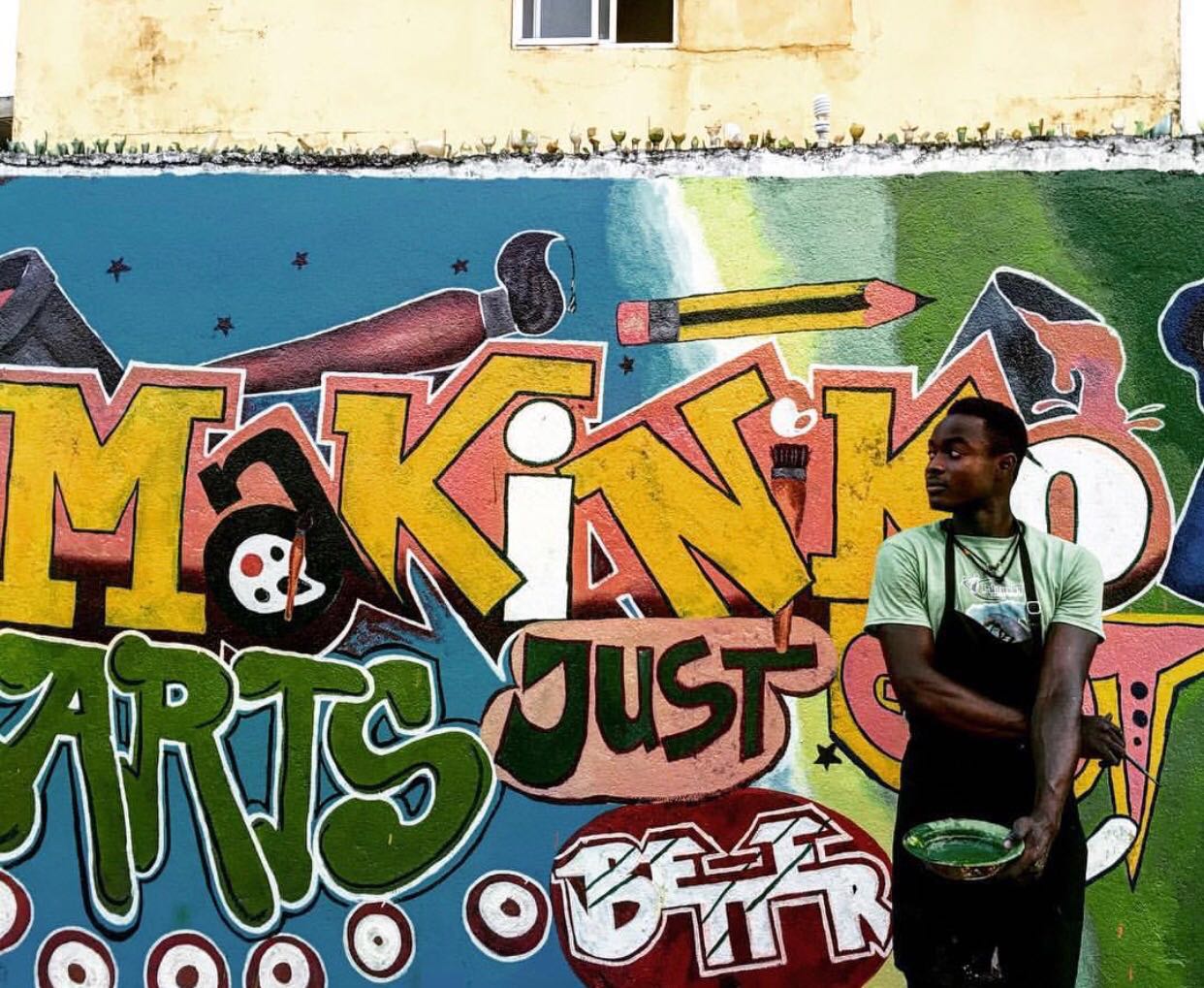Traditional masks, murals, painted storefronts, and paintings of beautifully shaped African women in village settings; these are a few reminders of the presence of art in Liberia.
Not all meets the eye from a single day’s drive through the vibrant city of Monrovia. In-fact, if one is not observant, understanding the movements and soul of the city can be quite difficult- Liberians are an interesting bunch, after-all. What is apparent, though, is the influence of art scattered across the country- from the brightly colored homes, to the vibrant fashion sense, and the unexpected sightings of dancing masquerades, or the country devils, as they are commonly called. With the obvious presence and influence of art in the country, one would think that there would be a greater support for arts in Liberia. However, this could not be further away from the truth.
During my schooling in the U.S, I developed a deep interest for the traditional arts and culture of Liberia. While on a visit at the Indiana Museum of Art, there was a display of traditional African masks. I recall standing in utter shock, awe, and anger after seeing the Bundu mask of the Vai people of Liberia. It was the first time I had seen a Liberian cultural artifact dating back to the 1940s; I was filled with mixed emotions. Anger, because I was reminded of the cultural exploitation against Liberia by the U.S, but inspiration too, because I knew the appreciation for our cultural artifacts I was experiencing in the U.S could also be duplicated back home.
In 2016, I relocated to Liberia after schooling in the U.S. and I was as inspired as ever, so I took to the streets of Monrovia — corner after corner, shortcut after shortcut– I had to know the city. I had to know the Artists of the city; I had to know the people, and so I did. After endless Saturdays of searching, I found an art studio in Congo Town, on the Tubman Boulevard, owned by renowned Liberian Artist, Abu Fofana. It became my Holy Grail! I soon spent many Saturdays with Abu, staring at his vibrantly beautiful portraits of Liberian women.
On one of those Saturdays, with sadness in his eyes, Abu educated me on what it means to be an Artist in Liberia.
“Nobody buys the work. People look at us like we are nothing. You go to other people’s countries, and it’s their own citizens that give value to their art, but here, we got to wait for the White man to buy from us before we eat.” He said.
I felt sorry. I wanted to help. I wanted to buy everything in the studio. I wanted to tell the world about his story. But who would listen? I left that evening with one painting.
Another Saturday brought me to Senzoki Beach on 19th street, Sinkor. It seemed to have been my lucky day, as I walked in while Makiniko Jupaul, who I believe to be one of the most talented young Artists in Liberia, was in the process of painting the Senzoki Mural. I sat and watched in admiration as he free-sketched the entire walls of the beach, slapping on each brush stroke to make an image only he imagined. He drew quite the crowd as visitors to the beach joined me in the comfort of watching him and giving suggestions here and there on what to add next to the mural of brightly colored inspirational words and men and women dancing, as they would on the beach. Raw, unfiltered, passionate talent, is what he has.
Speaking on the perception of art in Liberia, Makiniko said “I think people like the art; they just don’t support it, that’s all. If everybody who told me they like my art would support me, my life would be different.”
Makiniko, Abu, and the countless Artists and Art Dealers who I was privileged to find around Liberia and speak with, share similar sentiments on how the nation perceives art – the people know it exists, but do not care for it, and if they do, not many are willing to spend money on it.
Luckily, there are people trying to change that, people like Nykita Garnett of Creative Afrik and the Hotel Provident (HP) Gallery. Nykita is a Musician who has turned her love for Liberian art into action with the opening of the HP Gallery on 9th street, Sinkor at the Hotel Provident. Housing works from Artists like our friend Abu Fofana, legendary Liberian Artist Baba Shabu, among others; the gallery is a one-of-a-kind space sitting in the heart of Monrovia which has pioneered the cultivation of art appreciation in Liberia.
It would be an unfair statement to say that Liberians do not appreciate art, as the poverty in the country has impacted the priorities of the people. What I would say, though, is that the people who do have the funds to spend on art need to spend it on Liberian art, and not those from other nations. Art shows and other events showcasing art which I have attended were very well attended by both Liberians and foreigners alike. However, as both Abu and Makiniko stated, not many people purchased the art works. So how can we change this?
I believe that the art derived from a nation reflects the emotions and soul of that nation. Liberian art carries pain, hope, vibrancy, tradition, and love, just like the people. So why then, is the art not widely supported? It all starts with the leadership of the country. If they do not add priority to the arts and cultural aspect of the country, and, for example, retrieve the nation’s stolen artifacts and preserve the ones in our possession, there cannot be a greater appreciation for them beyond what already exists. While I appreciate the steps taken with the reopening of the National Museum, as it represents a great start to the major task ahead, there is a lot more work to be done.
For this reason, The Koloqua Dialogues has made it its mission to work toward the preservation of Liberian culture, and the showcasing of Liberian arts. Colonization from the freed enslaved people of America, coupled with the 14-year civil war has left Liberia wiped of most of its pre-colonial history, artifacts, and images. Likewise, the remnants of those colonial ideals have left the Liberian people without understanding of our past selves, which in turn has us lost as a people. As a result, the Koloqua Dialogues uses photography, storytelling, research, and art to recreate those lost images, and educate the people on those artifacts and traditions. We do this in hopes that it will support the nation by helping us find ourselves as a people, and understand that before that ship landed on Providence Island, there existed a nation of traditions, culture, and values. It is important that the nation today does all it can to bring forward those values and immerse itself back into its culture.
To learn more about Liberian Artists, Photographers, Entertainers, and everything in between and beyond, follow and join the dialogue at thekoloquadialogues.com.
Authored by Adrienne Tingba for The Koloqua Dialogues

